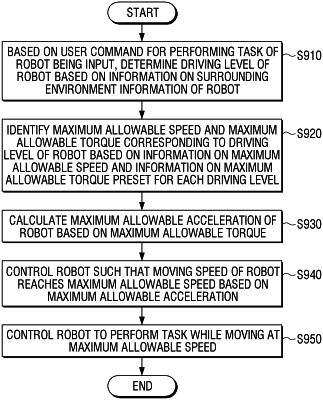| CPC B25J 9/1666 (2013.01) [B25J 9/162 (2013.01); B25J 9/1633 (2013.01); B25J 9/1697 (2013.01); B25J 13/003 (2013.01)] | 8 Claims |

|
1. A robot comprising:
a driving unit including a motor; and
a processor configured, based on receiving a command for performing a task of the robot to: determine a driving level of the robot based on surrounding environment information of the robot,
identify, based on information on a maximum allowable torque and information on a maximum allowable speed which are preset for each driving level, a maximum allowable torque and a maximum allowable speed corresponding to the driving level of the robot,
calculate a maximum allowable acceleration of the robot based on the maximum allowable torque,
control the driving unit to move the robot to reach the maximum allowable speed based on the maximum allowable acceleration, and
control the robot to perform tasks while the robot is moving at the maximum allowable speed,
wherein the surrounding environment information of the robot includes information on a space where the robot is located,
wherein the processor is further configured to:
based on information on a driving level for each space, identify a driving level corresponding to a space where the robot is located,
based on an image captured by a camera or a voice received through a microphone, identify a user located within a specified distance of the robot,
based on information on a driving level for each user, identify a driving level corresponding to the identified user,
based on the identified user being located within a preset range from the robot, determine a relatively high driving level as the driving level of the robot, from among the driving level corresponding to the space where the robot is located and the driving level corresponding to the identified user,
based on the identified user being located outside the preset range from the robot, determine the driving level corresponding to the space where the robot is located as the driving level of the robot.
|